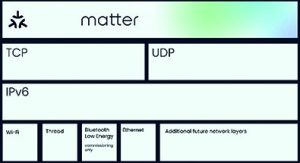
Matter officially began in 2019 as the Connected Home over IP Project (Project CHIP) within the Zigbee Alliance. Today it is a technology that is changing the face of the smart home.
That statement has been said many times and about many different technologies over the past 25 years. It carries a lot of weight, not only because of Matter’s member organisations – companies such as Amazon, Apple, Google and more than 600 others – but because of how it has endured ups, downs and updates and the level of co-operation around the industry.
Origins
Project CHIP brought together some of the most popular smart device ecosystems from Amazon, Apple and Google with the goal of creating a better smart home experience, or rather, promote interoperability between smart home devices and ecosystems. The Zigbee Alliance was rebranded as the Connectivity Standards Alliance (CSA) in 2021 to coincide with Project CHIP being renamed Matter.
The Matter stack (Figure 1) shows Matter as an application layer technology, sitting on top of Transmission Control Protocol (TCP) and User Datagram Protocol (UDP), using IPv6 as the internet layer protocol with IP-addressable technologies such as Wi-Fi and Thread as the physical and data link layers. While this model is a high level representation of the Matter stack, the underlying technology borrows from decades of previous work and development.

Figure 1: Representation of the Matter stack (Image: The Connectivity Standards Alliance)
The CSA came about in 2021 when the Zigbee Alliance, founded in 2002, was renamed. The Zigbee specifications still reside under the CSA as a separate working group. Matter borrows from previous Zigbee Alliance work in smart home automation and makes use of the Zigbee Cluster Library, or ZCL, which defines sets of functionalities that determine what an object can do. In Matter, the ZAP or ZCL advanced platform defines the endpoints, attributes and features of a device. These libraries define the types of devices that can exist on the network, such as light switches or thermostats, for example. These libraries will continue to expand as the CSA releases new versions of Matter and implements support for new device types. This means that the ecosystem of devices supported, including security cameras and home appliances, will continually expand.
The transport layer protocols TCP and UDP are used to exchange data between devices. Within each device within Matter’s device data model are one or more nodes where communication between devices terminates.
TCP is a connection-based protocol, which means it needs to establish a session with another device before sending data. This allows for a more reliable connection, but the overhead from setting up this connection, sending acknowledgements and resending lost data packets, takes time and energy.
UDP is a connectionless protocol, which means that it can transmit data without setting up a session between devices. This is the transport protocol used by Thread devices, which are often battery powered, for device discovery and other functionality. Within each device node there is a collection of endpoints and this is where the ZAP clusters live.
The capability of devices to be internet-addressable is a critical element of Matter and most smart home appliances. This is the default functionality for Wi-Fi and Ethernet-enabled devices, although this was not the case for most battery-powered devices that rely on small microcontrollers and limited memory. In 2004 the Internet Engineering Task Force started work to enable IPv6 compatibility for these devices. These efforts led to the launch of 6LoWPAN.
Continuing a Thread
In 2014, Thread was launched by the Thread Group with the purpose of enabling IP connectivity on low power and battery-powered devices. Thread is based on 6LoWPAN, which provides a translation layer from the relatively massive IPv6 packets to smaller packets, allowing for those resource-constrained devices to be IP-addressable. Thread introduced a great solution for those devices, using a border router that allows for Wi-Fi and Ethernet networks to communicate with Thread devices. Today most newer devices that are at the centre of a lot of smart homes, such as the Echo from Amazon, Apple HomePod and the Nest devices from Google, support both Thread and Wi-Fi and can act as border routers for low power Thread devices.
The goal of Project CHIP, and now Matter, is to unify and simplify smart home devices. The history of Matter is usually described as a highly collaborative effort, three years in the making, between a standards alliance and industry giants. That does describe it quite well, but if we look deeper into Matter we can start to appreciate it for what it is, more than 20+ years of tremendous effort and an evolution of many different technologies that is radically changing the face of today’s smart home.
What’s behind Matter
Matter is a single protocol to connect compatible devices and systems with one another, writes Caroline Hayes.
The Connectivity Standards Alliance (CSA) says that with Matter, all smart home devices are secure, reliable and seamless to use. It is designed for interoperability, with devices from multiple brands able to work natively together and with local connectivity that is consistent and responsive. It is built on internet protocol (IP) to enable secure communication across smart home devices, mobile apps and cloud services, and define a specific set of IP-based networking technologies for device certification for reliable and secure connectivity.
Developers such as Infineon, NXP, Silicon Labs, STMicroelectronics and TI, are all CSA members, as are Amazon, Apple, Comcast, Google, Huawei, Ikea, LG and Samsung.
The protocol simplifies the purchasing process for retailers as products can work across multiple platforms.
For consumers, Matter opens up choice, with a range of brands able to securely and seamlessly connect around the home because smart lighting, smart locks, phones and tablets can all be used to control Matter devices. Each new Matter device purchased is guaranteed to work with these smart home platforms.
 Electronics Weekly Electronics Design & Components Tech News
Electronics Weekly Electronics Design & Components Tech News



